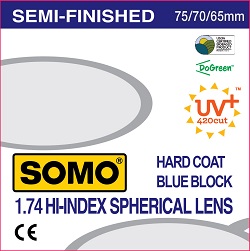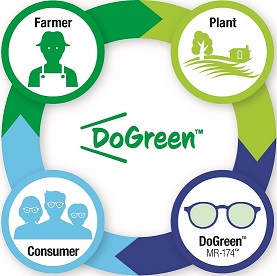
SOMO Spherical 1.74 Hardcoat UV420+
- Ultra Thin and Lightweight
- 50% Thinner and 50% lighter than CR39 Plastic Lenses
- 27% Thinner than Polycarbonate
- 15% Thinner than 1.67 Index
- Minimize Distortion at the Edge of Lens for Best Vision
- Ultimate Lens Design Technology
- Best Cosmetics by Reducing “Eye Shrinking” Appearance of High Power Prescriptions
- Hi Index
- Scratch-Resistant Coat
- UV420 – up to 420nm of Ultra Violet Protection
- Bonus Feature- Blue Block Protection
- UV420 & Blue Block is part of the monomer
Specifications
- Spherical Design
- MR-1.74 Material
- 1.74 Refractive Index
- 1.47 Specific Gravity
- 33 Abbe Value
- Scratch-Resistant Hardcoat
- Blocks UVA and UVB as well as High Energy Visible Light
- Maintains Clear Visibility while blocking harmful light
- Single Vision Semi-Finished recommended for Free Form processing
GO GREEN with our first bio-based lens!

Get To Know Our UV420+ Blue Block Products:
First you must understand the properties of blue light. There is good/beneficial blue light; there is bad/harmful blue light.
Before testing the efficacy of our blue block or UV420+ lenses using a blue light tester pen, it is important to differentiate between good and bad blue light. While some blue light is beneficial for color perception and regulating our circadian rhythm, there is also harmful blue light that should be blocked. Unfortunately, many people mistakenly believe that all blue light is harmful.
It is also important to note that the wavelength of the laser pens used in testing is 405nm, which is closer to violet light and does not represent the harmful blue light we aim to block. Our blue block lenses are specifically designed to block harmful high energy blue light, while still allowing beneficial blue light to pass through. Whether using our standard blue block, or UV420+ , it is important to recognize that harmful blue light will be blocked while beneficial blue light will still be transmitted.
Our types of lenses aim to improve visual comfort and provide benefits in blocking harmful blue light. Depending on the needs of the lab or ECP, either option will be a good choice for people wanting to reduce the impact of harmful blue light.
